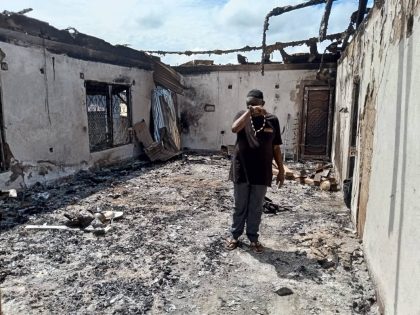The African Hip-Hop Generation Arrives
Frantz Fanon once said: “Each generation must discover its mission, fulfill it or betray it, in relative opacity.”

Blitz the Ambassador, 2010. By Joss Lio, via Flickr CC.
I remember it like it was yesterday. My older brother had just returned from his freshman year of secondary school and the loud engine of my father’s old Nissan Stanza pulling into the compound had sent us all rushing to welcome him. Amidst my parents chatter about his grades and how he’d lost weight, my brother signaled me to follow him. He pulled out a Sony Walkman and told me he had a new dance to teach me. I can’t remember exactly what he called it, only that it was similar to the running man. The soundtrack to that dance was a sound I had never heard before: ‘Hip-Hop music.’ I spent the days that followed filled with immense curiosity, digging into this new sound. Years later, I would come to learn the names of the artists on that cassette tape: Big Daddy Kane, Rakim, KRS One, Salt & Pepa, and Public Enemy. This was my introduction to a culture that changed my life.
I’ve always wondered what made Hip-Hop so captivating. Was it the beat? Perhaps, it could’ve been the hypnotic samples looped into 16 bar arrangements. Or was it the lyrics? Honestly, between the thick American accents and heavy slang, very few of my peers understood a word that these rappers said. So it must have been the urgency with which Hip-Hop artists asserted their views, a stark contrast to the love themed Highlife tunes our parents listened to. Most young people found that content redundant and Hip-Hop music helped break the monotony.
With a wide array of socio-political commentary from Public Enemy and deep ‘5 Percent Nation’ knowledge from Rakim laced over neck snapping beats, a majority of young Africans were spell bound by the sonic manifestation of the culture. I, however, was enthralled by the physical attributes of the culture, especially the fashion and style. Giant Africa medallions, dashikis and kufis were the core aesthetics of Hip-Hop of that period. In my twelve year-old brain, I interpreted all that Afrocentric style as a symbolic call and response from a distant relative. I heard the call loud and clear but how would I respond? Was Hip-Hop really interested in hearing about my struggles and appreciating my Ghanaian aesthetic? Did the culture really value its international roots? After all, the Godfather of the culture, DJ Kool Herc was himself an immigrant. His block parties were directly related to the sound system culture of his native homeland Jamaica. So the light bulb went off- maybe I had to journey to the Mecca of Hip-Hop, New York City. There my response would be heard much louder.
That journey took me from local talent shows in Ghana to graduating college in Ohio (I’m African, I had to do it for my parents) to numerous world tours and even sharing the stage with my personal heroes Public Enemy at NYC’s Summerstage. But somehow the response to the call didn’t seem adequate. It took a while to realize that the initial call I heard in Ghana was powerful because it came from a collective voice. Whether it was the Afrocentric era (Public Enemy, X -Clan, KRS One) or the Native Tongue era (Jungle Brother, A Tribe Called Quest, Queen Latifah, De La Soul) or the most recent Soulquarian era (The Roots, Erykah Badu, Talib Kweli, Common, Mos Def), it was clear that to make an impact you needed a definitive movement.
I started wondering: perhaps this idea of responding to Hip-Hop’s call rested not on me as an individual, but on a collective of young African voices. The more I searched, the more I found like-minded artists who were responding in their own way- from Somali-born MC, Knaan, to Belgian-based Congolese Rapper Baloji to Nigerian-German singer Nneka (the list goes on). We had all made inroads individually but had hit a similar brick wall collectively- being a solitary voice in the extremely territorial world of Hip-Hop. None of us could make enough noise to shift the paradigm, no matter how brilliant we were as individual artists.
So, some of us began a quest to help present a unified front- from collaborations to guest appearances to curating live shows and stalking the Facebook pages of some of our peers till they responded. We now understand that our power lies in our connectivity. To quote the brilliant scholar Frantz Fanon: “Each generation must discover its mission, fulfill it or betray it, in relative opacity.” I believe we are the next generation of Hip-Hop. A more globally focused generation, one that can bring back the same urgency we heard in our native countries when the culture first beckoned us. Thanks to the Internet, this movement continues to connect everyday. I believe there is nothing more powerful than an idea whose time has come. The time for Africa’s Hip-Hop generation to influence the culture that influenced it is now.



















